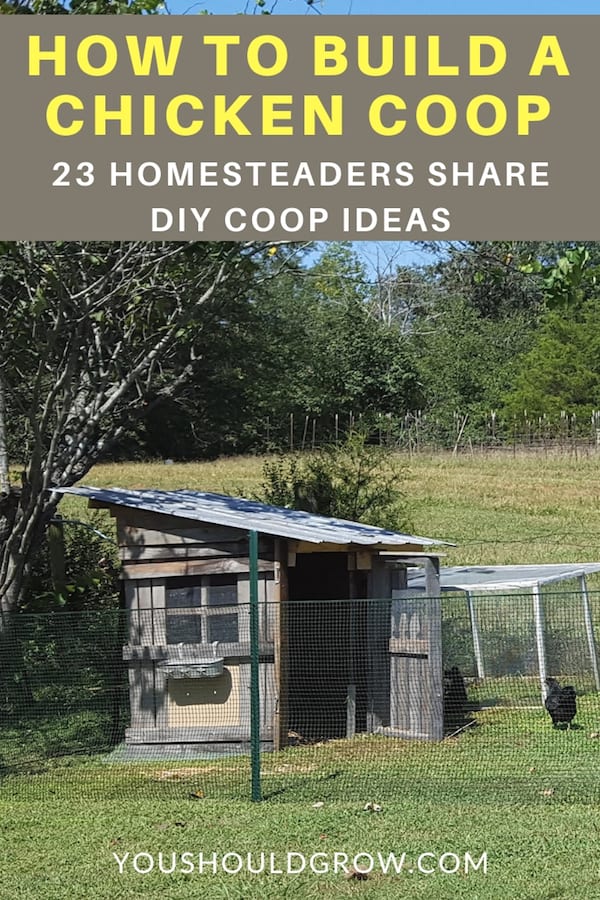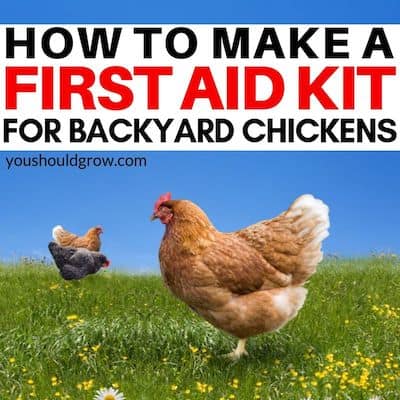How To Build A Chicken Coop: 23 Pictures Of DIY Coops
As an Amazon Associate and member of other affiliate programs, I earn from qualifying purchases.
If you’re thinking of getting a few backyard chickens, then you’re going to need a safe place to keep them at night. Buying a chicken coop can get expensive, so in this article, I’m going to tell you how to build a chicken coop that fits your home, birds, and budget. Plus, I’ve gathered some excellent cheap coop ideas from real homesteaders for you to use as inspiration.
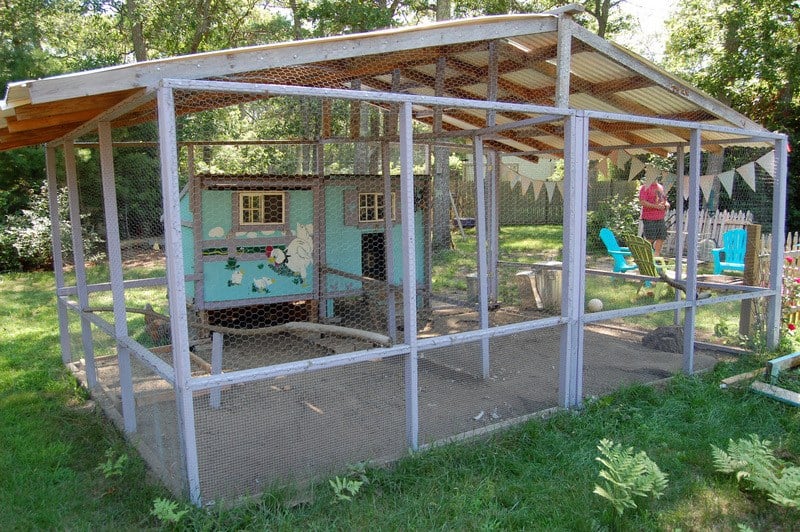
Backyard chickens are becoming more and more popular as pets and working animals on a homestead. In addition to their lovely eggs, chickens eat common garden pests, leftover kitchen scraps, and their droppings can be composted to fertilize your garden.
They’re also pretty low maintenance, and they don’t need an elaborate coop to keep them happy. If you’re the thrifty DIY type, you can build a chicken coop from things you collect or find so long as it meets a few requirements.
Building a chicken coop can be as simple or as complicated as you want it to be. There are lots of resources available that provide exact building plans, and I recommend getting a couple of coop design books to use as inspiration.
We have now built 3 chicken coops, and we saved money by using collected materials from around the farm including some metal roofing, spare lumber, and old pallets. We only had to purchase hardware like screws and locks for the door as well as ¼” hardware cloth to keep the chickens safe.
Basic chicken coop requirements
When you’re trying to use random gathered materials, you will have to do a bit of creative thinking to put your coop together. So let’s talk about the necessary design elements, things to consider, and finally how to build a chicken coop.
Do you want to:
- Harvest fresh eggs from your backyard?
- Have a custom built (and super cute) coop for your flock?
- Build your own coop (even if you don’t have woodworking skills)?
Get 15 DIY Coop Plans That Anyone Can Build
“As someone who doesn’t know much about building, this was a lifesaver. Thanks to Easy Coops, I was able to build a creative new coop for my chickens. With the previous coop, I worried that there wasn’t enough insulation, and that it might’ve been uncomfortable for my chickens. When I noticed it seemed drafty and cold, I decided I need to build a better coop in order to properly care for my chickens.
And now, I have no worries about the coop I built using simple step-by-step instructions from Easy Coop. I was concerned that the instructions might be tough to follow, but they really do make it as simple as possible. With recommendations on how to choose the right coop layout, suggestions for what materials to use, and how to utilize the land space you have available, this guide covers everything you’ll need to know as you’re building your coop.
I would certainly recommend it to anyone who needs to build a simple new coop, anyone who wants to build a high-quality coop, or newcomers that don’t know much about raising chickens. There’s so much important information included, and it only cost a small fraction of the price of buying a new coop.
I was considering giving up on building a coop and purchasing one, but I’m so glad I chose to give Easy Coops a try instead!”
Gail Smiths – Farm Owner – Idaho, United States
Chicken coop size
The first bit of advice any chicken owner will tell you is not to underestimate how big to make your coop. If you’re like me, you’re saying 4 or 5 chickens but what you really mean is one of each breed of chicken.
So build your coop larger than you think you’ll need or at least plan for a way to add on to it in the future.
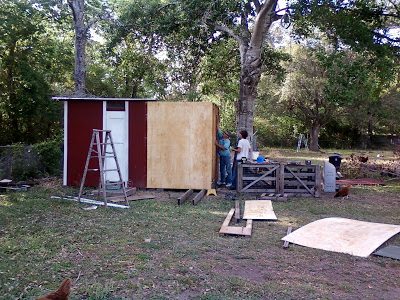
The space requirements in a chicken coop are 4-10 square feet per bird. If you’re letting your chickens out to free range or in a run, they don’t need as much space inside the coop. Four square feet per bird is sufficient if they only stay in at night.
If you’re not free ranging your birds or letting them out in a run, give them a minimum of 10 square feet per bird inside the coop. Chickens that are crowded in their coop can develop health issues like respiratory disease, skin infections, and behavioral issues like bullying and eating eggs.
Chicken coop ventilation
In my experience as a veterinarian, I can tell you that treating respiratory disease in chickens can be very difficult. And coop design has a lot to do with your chicken’s health.
Chicken droppings pile up and as they decompose, ammonia is released into the air. Chickens also like to scratch around which makes lots of dust. Can you imagine being stuck in a room full of feces, ammonia, and dust? Oh my gosh. NO!
Providing adequate vents also makes sure that heat doesn’t build up and become stifling in the coop. So you just need to make sure there are some windows or vents to allow for fresh air to flow in and out of the coop. If you don’t provide adequate ventilation, you’ll surely end up with a sick chicken.
Vents placed higher in the coop allow ammonia to escape. Ammonia is lighter than air so it will naturally float out the upper vents. I also like to provide a lower vent to allow in a breeze. This helps keep the coop dry and prevent moisture from building up. Excessive moisture on the floor of the coop will trap ammonia like a wet blanket so it can’t float out.
When you’re building your own coop, you also want to consider how wind and rain might enter your vents. If you live somewhere where it gets very cold, you may not want as many vents.
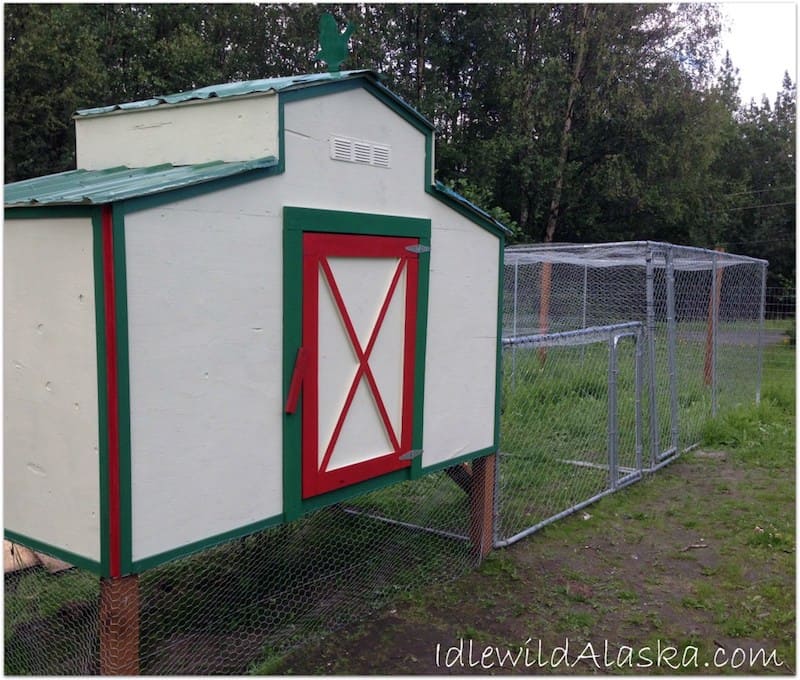
I like to add a lot of ventilation in our coops. We live in the south and it’s very hot and humid in the summer, so it makes sense that I need to provide a lot of ventilation. In the winter, it’s not very cold here so I can quickly staple up a tarp in front of large gaps to block the wind, and the chickens are perfectly fine.
There’s not an exact calculation to be done here. I just think about how I would want the coop to be if I lived in there. I also think windows are a fun way to add a decorative accent to your coop. Whether it’s a traditional paned window or even cut into shapes like these stars, this is a fun place to get creative with your coop design.
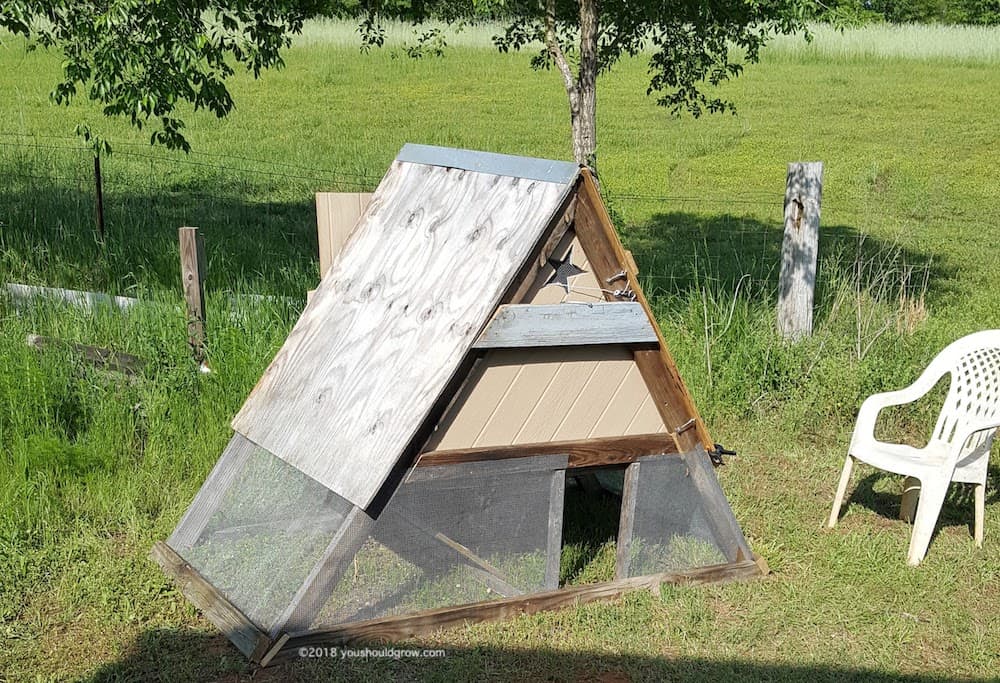
It’s super important to remember to cover all the vents or windows with hardware cloth to protect your birds from predators. Which brings me to the next requirement for chicken coops…
Chicken coop safety
Chickens are a very vulnerable prey animal. And unfortunately, it is very common to lose chickens to predators like hawks, foxes, coyotes, and dogs. Because of their small size, chickens are easy prey, and it is part of your job to make sure they are protected.
As you design your coop, think about how you will cover any gaps and holes. Holes as small as an inch in diameter are large enough for raccoons to reach in and grab your birds, not to mention snakes and rodents.
If you’re building a coop from pallets, for example, you might have holes or cuts in your wood that don’t meet up exactly. For these, I simply staple in hardware cloth the best I can.
It’s also possible to use 2 layers of fencing to close gaps if necessary.
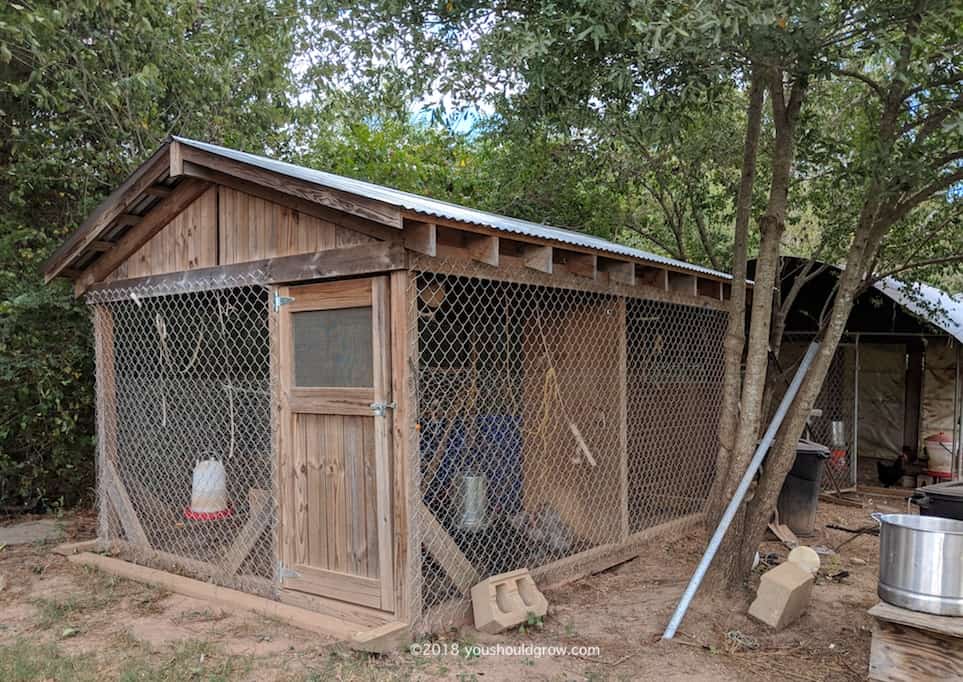
You’ll also need a lock on your coop door as hungry animals can be very clever in their methods of entry. A bolt or tight fitting hook and eye lock are usually sufficient.
Additionally, you’ll need to protect your birds from predators that try to dig under the coop. It’s best to bury hardware cloth under the edge of your coop and out 12 inches away from the coop. The idea being that predators won’t be able to dig through the cloth to get into the coop.
I do think having a dog on your property helps keep some predators at bay. They won’t scare off every animal that wants to eat your birds, but their scent and activity around your property can deter some.
Roosting bars and nesting boxes
Chickens instinctively roost at night. Provide a roosting bar for your birds to get up off the ground to sleep at night. Make sure it’s at least an inch wide to be comfortable for your hens.
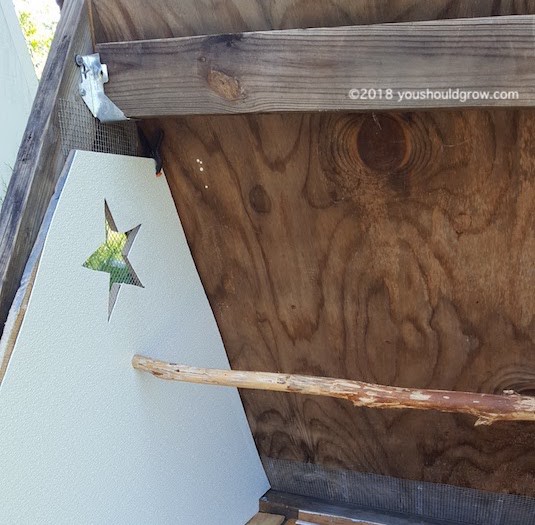
When choosing where to place your roosting bar, pay close attention to the items that will stay underneath the roosting bar. This will be where the majority of the fecal material collects so try to keep that area free of other items so that it is easier to clean.
Nesting boxes can be in the coop, but not underneath the roosting bar. You only need one nesting box per 3-5 birds, but you can have more. You can build a custom nesting box or repurpose things like crates, buckets, flower pots, and bins for your girls. They like a cozy, private area for laying eggs, but make sure it’s easy for you to access and collect your precious eggs.
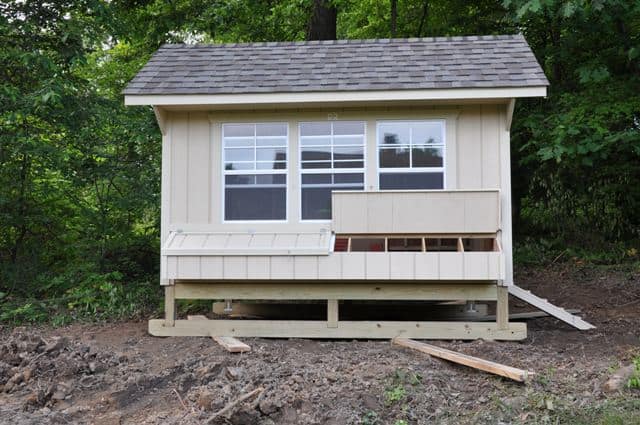
You don’t need space for food and water in the coop unless they are staying in there all day. In fact, they’ll likely make a huge mess out of any food or water you try to leave inside, so in my opinion, it’s much simpler to place their food and water out in their run.
Basic chicken coop requirements recap
- Space – make it bigger than you think it should be
- Ventilation – air flow in the coop is key to healthy chickens
- Safety – protect your birds from aggressive predators
- Roosting bars and nesting boxes – give them a place to roost and lay eggs
Now that you understand the basic requirements, read through the following considerations to make sure you plan for a coop that is perfect for you.
More things to consider when building a chicken coop
Cleaning the coop
The first consideration will be cleaning the coop. Chicken coops get stinky and dirty really quickly! Every night your chickens will deposit another pile of droppings in their coop, and I find the easiest way to keep a chicken coop clean and fresh is to use the deep litter method.
But you can still make things easier on yourself by:
- Be strategic about your roosting bar placement. Droppings pile up very quickly underneath roosting birds. You don’t want your roosting bar over your nesting boxes or any cracks or crevices where it will be hard to clean.
- Give yourself easy access. Whether that means your coop is large enough for you to walk in or you have a very large door on the side, make sure you can open that coop up and get it clean without having to contort your body to reach in.
- Choose an easy to clean flooring material. This could mean linoleum applied over a wood floor or even a large piece of plastic or roofing. But in smaller raised coops, you can also use hardware cloth for the floor.
Weatherproofing your chicken coop
Chickens need to be protected from wind and rain as well as heat and to some extent cold. In colder climates, your coop needs a solid roof and walls to keep your hens warm and dry. In warmer climates, your coop walls and roof might simply be a tarp attached to fencing.
Make sure you account for vents and windows where rain can enter and drench your birds while they’re sleeping. You want to keep them as comfortable as possible for healthier, more productive hens.
Depending on the breed, chickens are cold hardy to well below freezing so most coops simply need to protect the birds from wind and rain. Chickens will huddle together at night, and they can actually warm up a cold coop simply with their body heat.
If you get very cold winters with daytime temps near 0, you might choose to install insulation in your coop. However, heaters are usually not necessary and can be dangerous.
Do you want a stationary or mobile coop?
Mobile coops allow you to move your chickens around your property for grazing. Sometimes, mobile coops are smaller or built of lightweight materials so they’re easier to move. But sometimes they’re full-sized coops on trailers or even wagon wheels.
Some mobile coops are little more than a PVC frame with chicken wire over them. You can also choose to make a mobile chicken run that detaches from the coop so the birds can have new areas to graze but stay where you want them.
Here are some examples of mobile chicken coops.
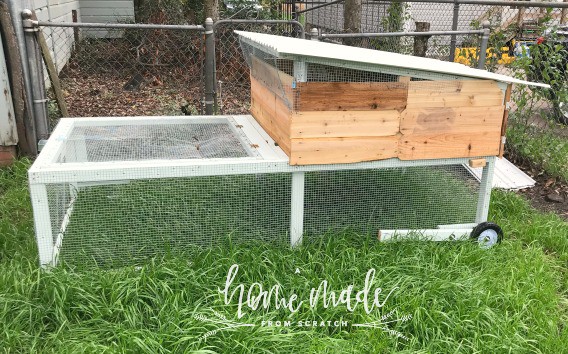
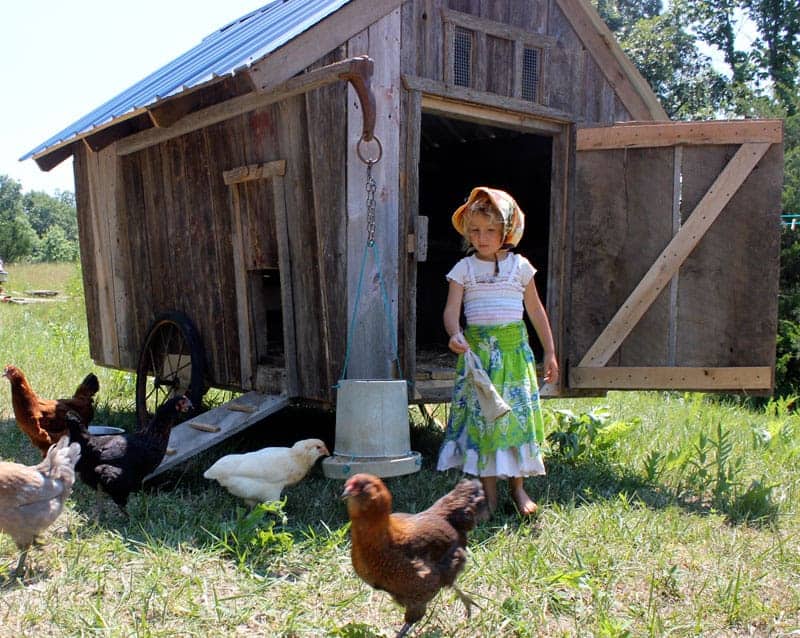
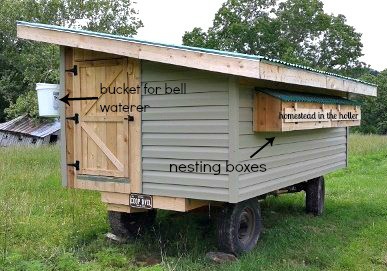
How many chickens do you want?
It’s better to plan for a few extra chickens than you think you will get. They have a mysterious a way of multiplying. Once you get one chicken, somehow you suddenly have 5. Either because you saw one of that was really cute or because now that people know you have chickens, they keep trying to give you more.
I think it’s also better to give your birds a little extra space. Chickens can be quite mean to each other so err on the side of caution to prevent behavioral issues.
Will you also build an enclosed run?
We currently allow our birds to free range during the day, but speaking from experience, providing them with an enclosed run is better. They tend to get into everything especially your herbs and flowers, and their droppings can become a minefield you have to navigate with every step.
Also, if you let your chickens free range, you will eventually lose a bird to predators. There is a 100% chance of that. I don’t mean to say that to scare you, but I think it’s important to realize. Even if you’re only letting them roam during the day.
I know because I let my birds free range quite a bit, and I’ve cried over many lost chickens. Needless to say, I am not letting my chickens have much free range time anymore.
There are ways to make free ranging safer for your birds, but there is always a risk. So keep that in mind when you’re designing your coop. You may also want to build a covered run and include some fun chicken toys at the same time.
Here are some great examples of coops with attached runs.
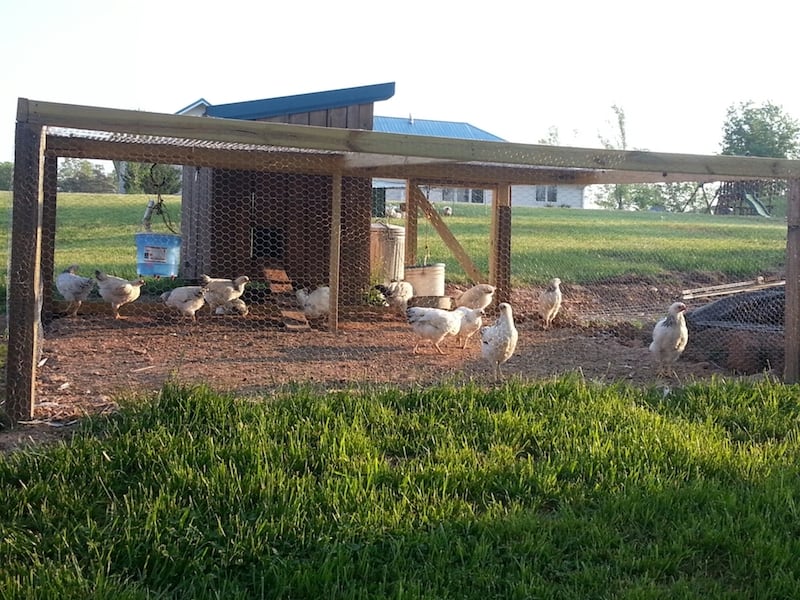
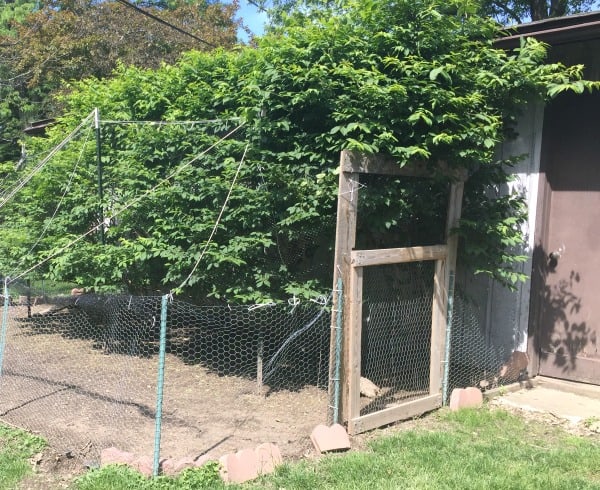
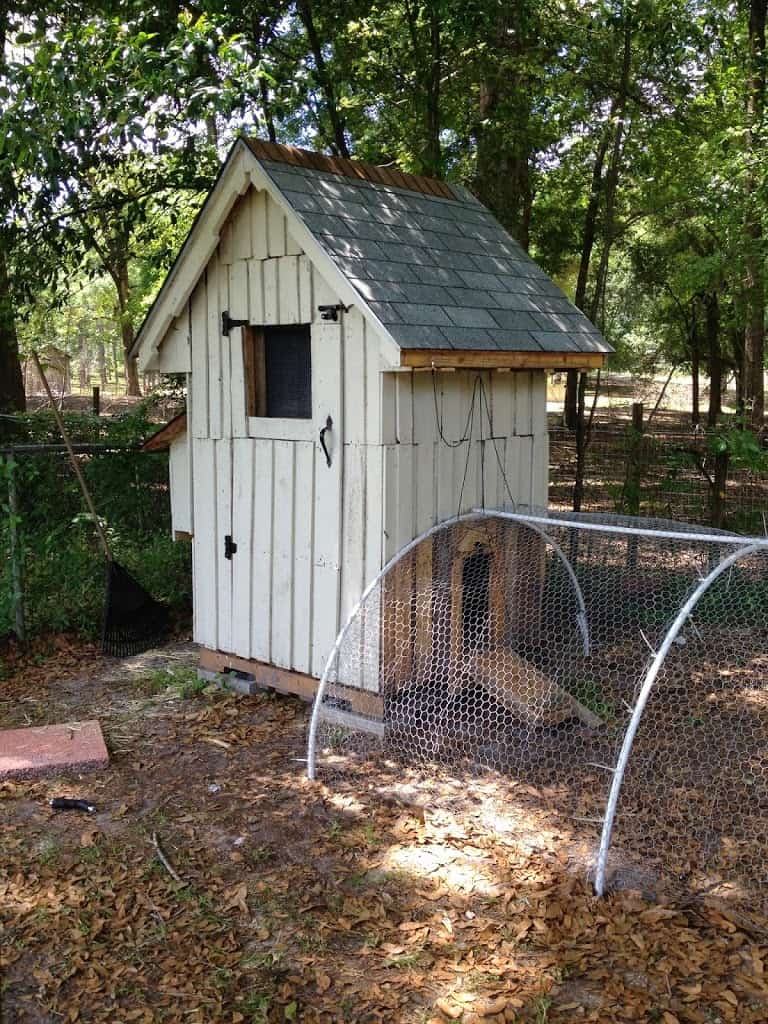
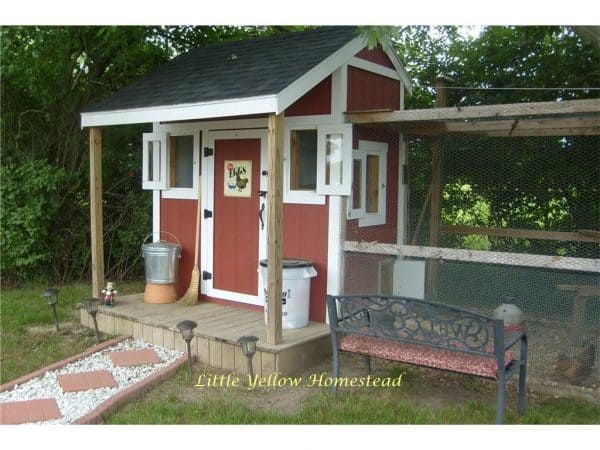
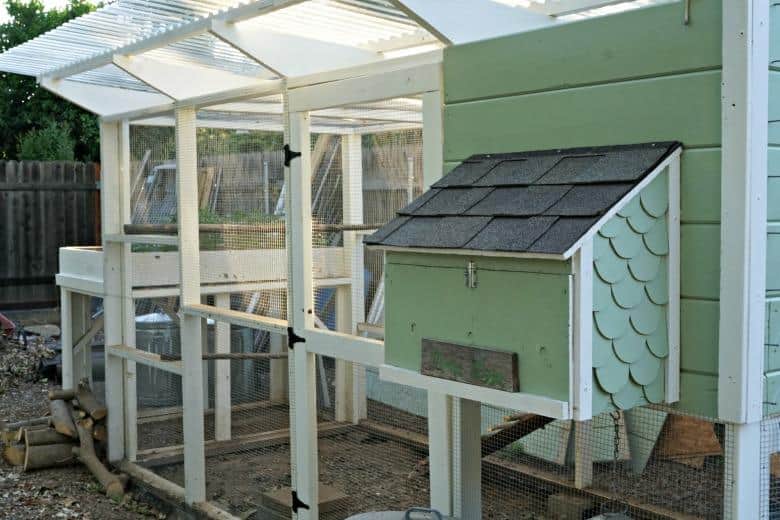
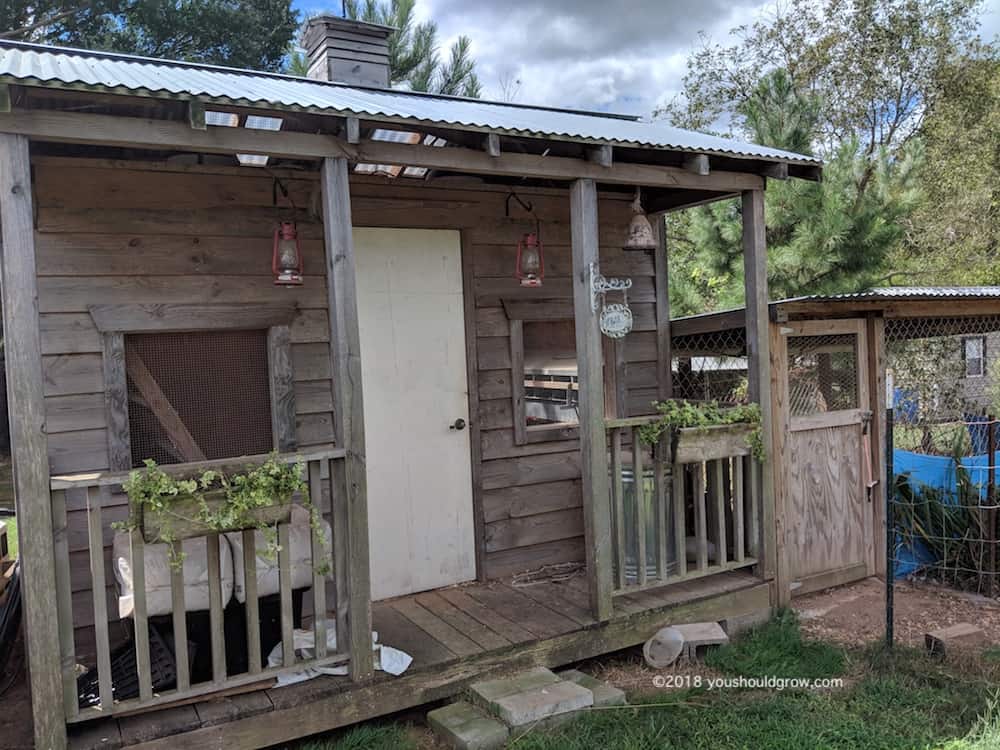
Do you want an automatic door?
If you don’t want to be running out in the rain and snow to close your chickens up, consider planning for and installing an automatic door.
Automatic doors can be programmed to open and close at certain times of the day, which makes it easy to keep your chickens are locked up safe at night and you don’t have to worry about the weather or not being home to lock them in.
If you’re building from things you collect for free or cheap, then make sure you build in a space that fits an automatic door if you want one.
How to build a chicken coop for free or cheap
If you’re piecing together a coop with items you find for free or cheap, you’re really at the mercy of the materials you can find. Pallets are pretty easy to find and set up, but there are a lot of gaps and holes you have to account for.
So step one is to gather your supplies. Here are examples of things you might find at garage sales and on craigslist that you can use to build your coop:
- pallets
- T-posts or U-posts
- lumber: we used a lot of 2x4s & 2x2s, but any lumber such as fencing can also be used
- PVC pipes, joints, and joiner
- roofing – metal roofing or shingles
- plastic tarps
- plywood
- linoleum flooring or other waterproof surface coverings
- construction adhesive
- hardware cloth and chicken wire
- chain link or other type of wire fencing
- 2-inch wood screws
- hinges, locks
- roosting bars: ladders, branches, broomsticks, picket fence posts, 2×2 lumber, etc
- trampoline frames
- playhouses or dog houses
- For nesting boxes: 5-gallon buckets, crates, large plant pots, etc
Once you have your materials, you’ll need to pick out your 4 walls and roof. For this, you might build a frame and attach metal roofing to create a wall, or you might use whole pallets stood up on their end. Sliding pallets over t-posts is a good way to get pallets to stand up on their own. Attach your four walls together with woodscrews building frames if you need them.
With all 4 walls up, you’ll add your roof. We had to build a simple frame to screw the roofing into, but what you need will depend on the items you’re using to build the coop.
If you’re modifying playhouses or doghouses, you’ll need to reinforce them for safety, add your nesting boxes and roosts, and attach a run.
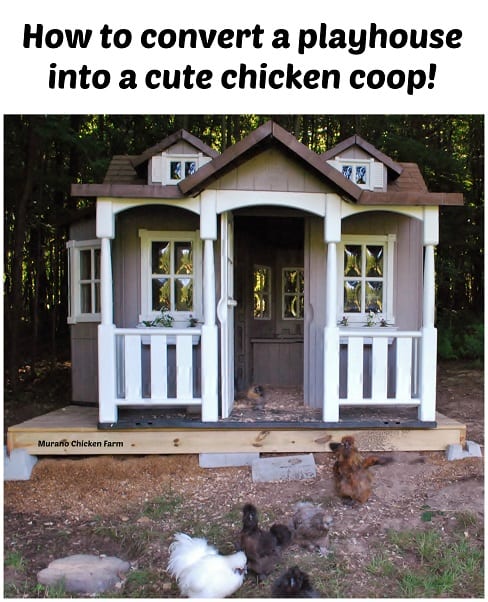
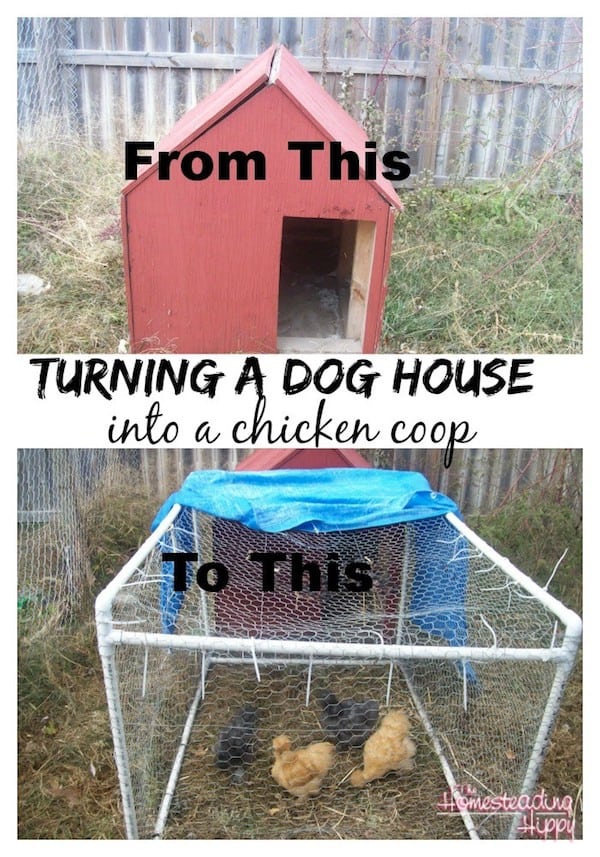
Whatever you’re using to build your coop, you need to cover all holes and gaps with hardware cloth, wood, or other found material. Hardware cloth is much stronger than chicken wire, and it’s easy to attach with staples and screws and washers.
Using hardware cloth over holes and gaps also allows for plenty of airflow, but in cold climates, you might choose to cover some gaps with wood planks or other solid material.
Chickens really don’t care about what their coop looks like, so all you need to do is pull together 4 walls and a roof to keep them happy. Take a look at some of these simple chicken coop designs.
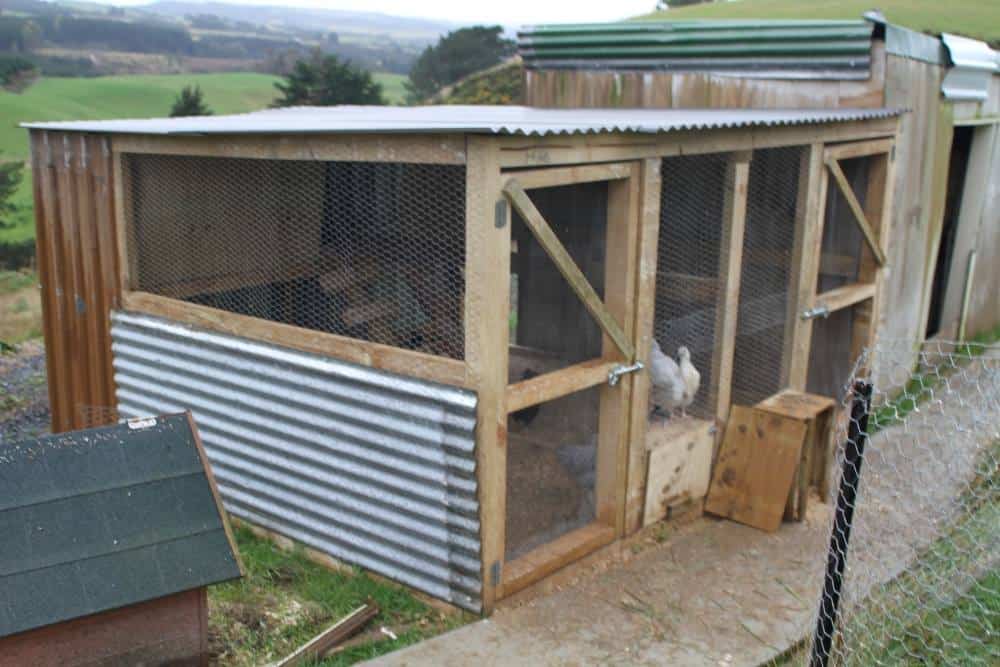
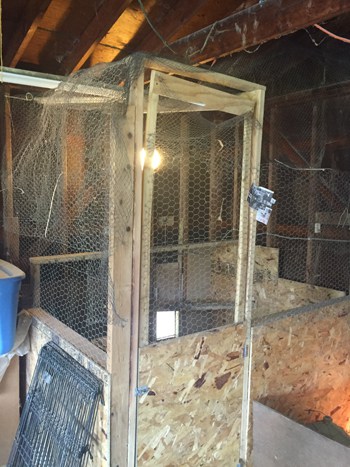
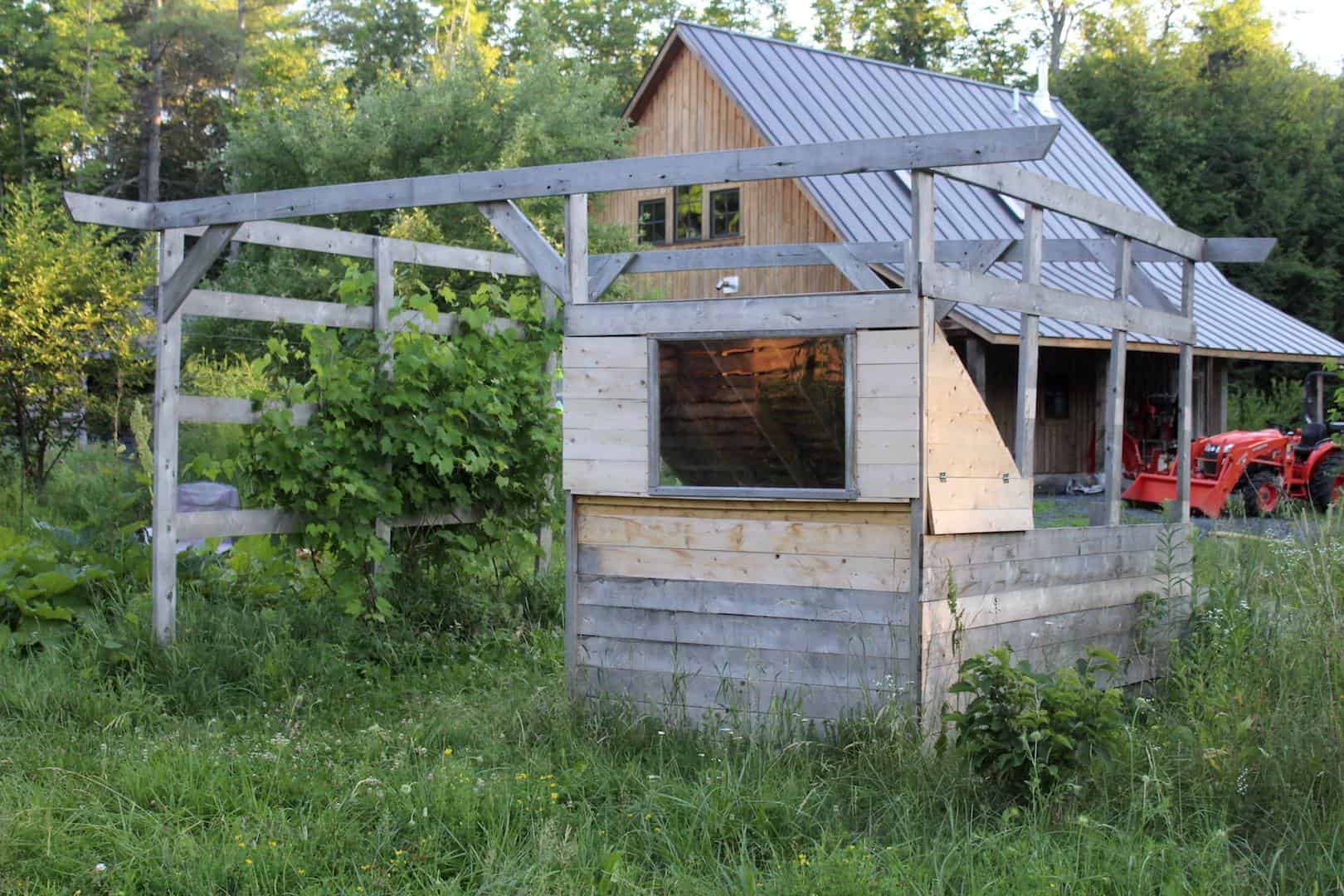
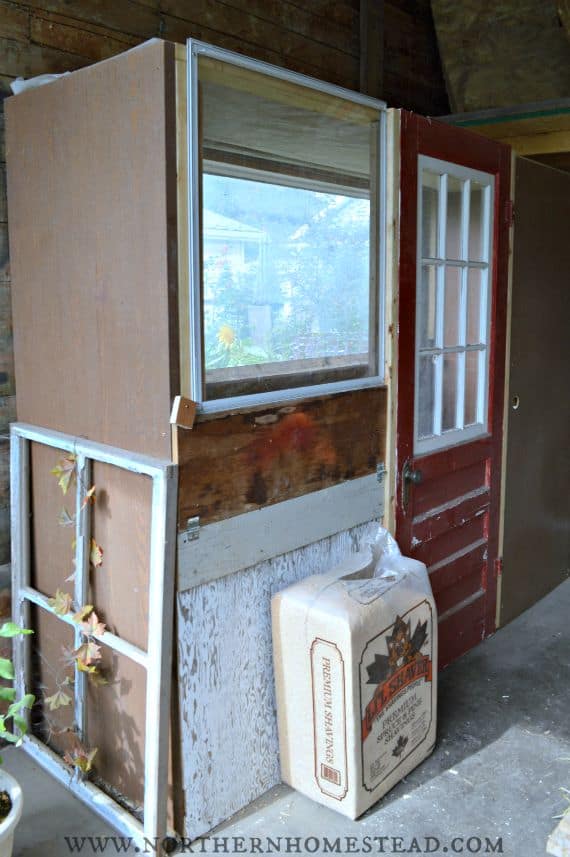
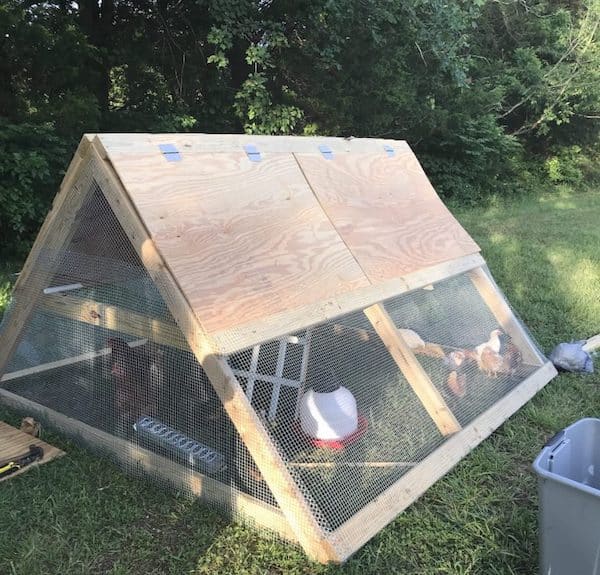
Will you add decorative touches?
This is the most fun part! Remember to include any decorative touches you’d like on your coop. Things like the shape of your windows and clever coop signs can add a fun touch. Decorating your chicken coop can be especially important in urban and suburban settings or if it’s right in your backyard.
Flower boxes and trellises really dress up a coop and run area. Plus, fragrant plants can help with odor, flies, and ants.
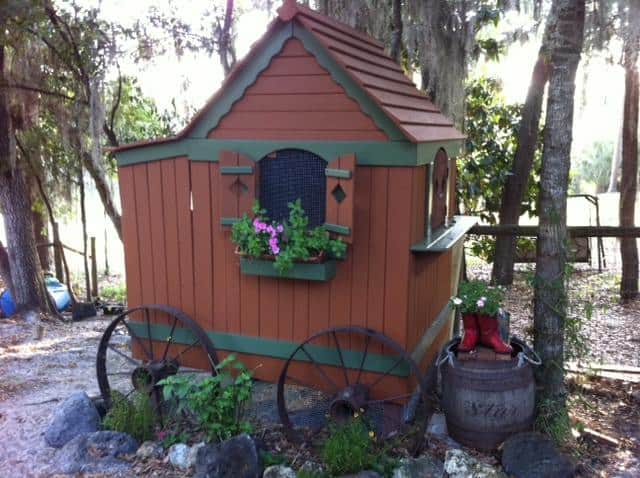
Final thoughts
Raising a few hens in your backyard is a great way to add pets with a purpose to your family. Chickens are funny little creatures that provide endless fresh eggs and fun company.
I hope you found some direction and inspiration for your own chicken coop in this post, and it encourages you to jump in and start raising some chickens of your own.


